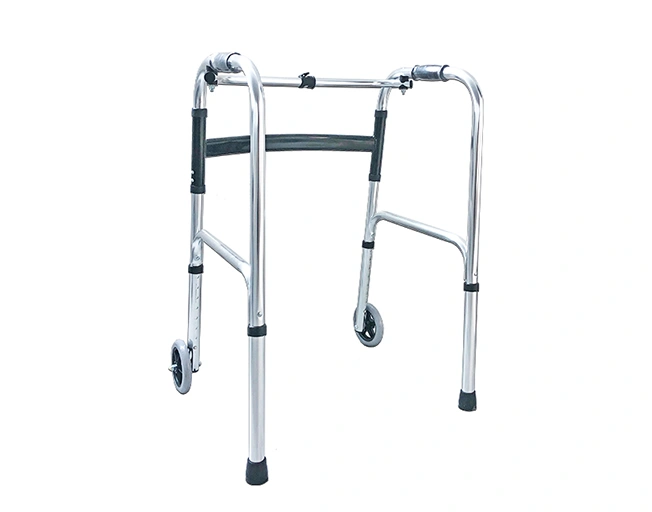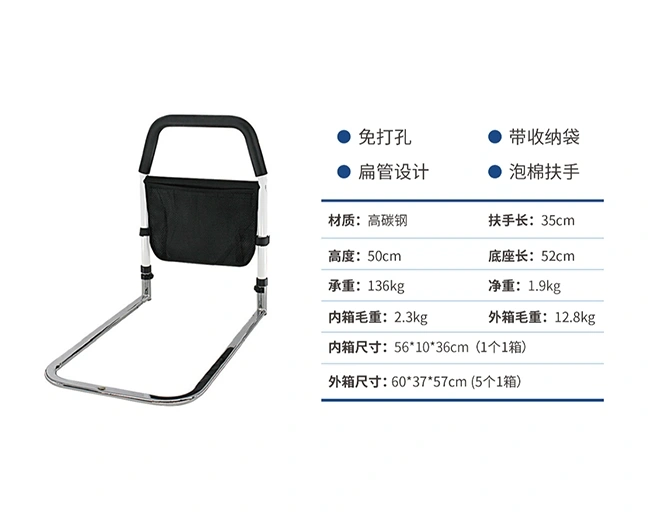How to Adjust Walking Frames for Elderly to Ensure Proper Posture
Time : Nov 03, 2025 View : 440
As we age, maintaining mobility and independence becomes increasingly important, yet challenges like reduced balance, joint pain, or muscle weakness can make everyday walking difficult and risky. Walking frames, also known as walkers, serve as essential mobility aids for the elderly, providing crucial support to prevent falls, reduce strain on the body, and promote confidence in movement. However, an improperly adjusted frame can lead to poor posture, discomfort, or even injury, undermining its benefits. This guide explores the key factors to consider before adjustment, offers a step-by-step process for achieving optimal handle height, arm positioning, and upright alignment, highlights common mistakes to avoid, and shares maintenance tips for long-term safety. By partnering with trusted suppliers like Xunyu Medical, users can access high-quality aids tailored to senior needs, ensuring safer, more comfortable mobility and a better quality of life.

Key Factors to Consider Before Adjusting a Walking Frame
Before you change a walking frame, think about a few big things. This makes sure it fits and works well.
Assessing the User’s Physical Condition
First, check the user’s body and health fully. Look at height, arm size, and usual stance. These help find the right starting points for setup. And they affect how the frame should sit for best help and ease.Think about issues like joint pain or back problems. These can change how the user holds or moves with the frame. Joint pain may hurt grip or bend. Back issues might need special tweaks. This keeps the spine straight. It also eases pressure on the back and shoulders.
Choosing the Right Type of Walking Frame
Know the types: basic walkers, ones with wheels, and rollators. Basic walkers give top steadiness. Users lift them each step. They suit those with strong arms but weak balance. Wheeled walkers make moving simpler. And they keep steady. They fit users who need help but can keep a walking beat. Rollators have wheels, seats, and bags often. They give the most ease for active folks.Match the type to the user’s moving skill and places they go. Think if it’s for inside or outside. Or about stairs or bumpy ground. And their moving limits. This keeps the device safe. It stays useful every day.
Step-by-Step Guide to Adjusting a Walking Frame for Proper Posture
Fixing a walking frame right is vital. It helps keep good stance. And it stops hurts.
Setting the Correct Handle Height
The main fix is handle height. It should push good stance. And it cuts strain. Handles must line up with the wrist fold. This happens when arms hang loose by sides. It makes a natural spot for moving and help.Wrong height can make users bend. Or it hurts shoulders. It leads to lasting stance issues and unease. If handles sit too low, people hunch. This stresses the spine. And it cuts sight. But if too high, shoulders rise. This brings tight feeling. It causes tiredness in neck and upper back.
Ensuring Proper Arm and Elbow Positioning
After handle height, work on arm spots for best use. Elbows should curve about 15–30 degrees. This is when gripping handles. It gives a normal arm pose. And it lets weight spread well. Movement becomes easy.This spot boosts natural steps. It cuts tiredness. Arms work best in this range. Good elbow bend also keeps grip strong for long times. And it lowers stress on wrists and lower arms.
Aligning the Frame for Upright Posture
Last fix makes sure the frame pushes straight walking. Not leaning ahead. This is key for spine stance. And it stops forward head or curved shoulders.Tweaks may help spine line. This is especially for those with stance or back troubles. The frame should let users stand tall. Head up. Shoulders back. This builds sureness. And it brings safety in steps.
Common Mistakes When Using Walking Frames and How to Avoid Them
Know and skip usual errors. This keeps walking frame use safe. And it stays good.
Using a Walker That Is Too High or Too Low
A top error is wrong height. It can mess gait. Or cause back ache. And wobble. This hurts ease and safety.If too high, shoulders lift. Arms tire. If too low, users bend ahead. This stresses spine. And it cuts steadiness. Check height often. Tweak it. Do this as user changes happen.
Improper Foot Placement While Walking
A big safety slip is wrong step order. Feet go first. Then frame—not the other way. This order keeps steady. And it cuts trip risk.Many move frame first. Then step in. This makes a risky gap in help. It raises fall chance. Good training helps. Practice builds right moves.
Leaning on the Walker for Full Body Support
Users must see walkers as moving helpers. Not full weight holders. Too much lean can tip. And it hurts. Frames give balance and help. But they can’t hold all weight safe.Heavy lean tips frame front or side. This causes bad falls. Users should bear own weight as much as they can. Use frame for balance only.

Maintenance Tips to Keep Walking Frames Safe and Effective
Check often to keep frames safe. And working.
Regular Inspection of Parts and Joints
Do safety looks often for best work. Check loose screws. Worn grips. Or hurt wheels. Find dangers early.Watch tweak parts. Brakes on wheeled ones. And moving bits. They wear over time. Spot issues soon for quick fixes. This stops crashes.
Limpar e armazenar as melhores práticas
Good care makes frames last. And stay clean. Use soft soap for wash. Skip strong stuff that harms parts.Keep in dry spots. This stops rust or damage. It is big for metal frames. Store where no bumps hit. Or hot or cold extremes.
Xunyu Medical: Trusted Supplier of Mobility Aids for Seniors
Pick a known maker for top quality. And trust in long use.
Quality Products Designed for Safety and Comfort
Foshan Xunyu Medical Technology Co., Ltd. sits in Danzao Town, Nanhai District, Foshan City, Guangdong Province. It makes helpers for old folks. The firm builds many aids for seniors. These include Crutch, walkers, Bath chair, bedside commodes, toilet armrests, Manos de cama, toilet risers, and more.The full list meets moving and safety wants. Old users find right fixes for their needs. Each item puts safety and ease first.
Commitment to Elderly Care Solutions
From the start, the company sticks to new ideas in tech. It keeps bettering designs and jobs. This fits real old people needs. The promise makes items grow with user changes. And it adds new safety. Plus better looks.From the start, Xunyu Medical puts tech newness first. It fixes designs for real old folks wants. Its focus on use and easy features wins trust from buyers all over. The world reach shows care for old people everywhere. With trusty moving fixes.

Conclusão
Good use of walking frames needs care in fix. Spot. And check. Follow rules for height. Stance line. And looks often. Users get most from aids. And cut risks. Team with known makers and health pros. This gives top items. And expert tips for best results.
FAQ
Q1: How often should I check if a walking frame still fits properly?
A: Check walking frames for fit every three to six months. Or do it when user body, meds, or moving changes. Often looks keep safety and good work. Things like weight shift, stance change, or health growth can shift best frame spots.
Q2: Can I adjust a walking frame on my own?
A: Basic height tweaks can be done alone. Follow maker guides. But start fit and big changes should be by health worker or trained person. They make sure right measures. And they teach right use. Plus spot special needs from health or moving limits.
Q3: What signs indicate that my walker is not adjusted correctly?
A: Big clues are back hurt. Shoulder pull. Tire in usual use. Hard to stay straight. Wrist or lower arm ache. And wobble in steps. Also, if you lean hard on frame, have balance trouble, or step pattern changes, the walker needs tweak or pro look.


